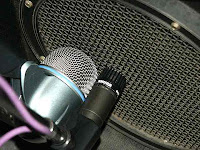 |
| Using a Beta 52 and SM 57 on the bass cabinet |
"Back in the 60’s and 70’s, the way engineers recorded the electric bass was by miking the bass amp. As direct boxes became more and more available, the trend eventually swung the other way, with most bass recording done direct. Today it’s very common to record a bass using a combination of both an amp and direct, which provides the best of both worlds. While the bass will sound full and warm with a direct box, the amp can add just enough edge to help the bass punch through a mix.
When using a direct box, be aware that they’re not all created equal in that some will not give you the low fundamental of the bass that you expect when recording this way. Active DIs do a better job at this than passive, although some passive boxes (like the ones made by Radial) do an excellent job because of the large Jensen transformer used in the circuit.
Depending on the sound that fits the track best, mix the amp track with a DI track. The sound will change substantially depending upon the balance of the DI and miked amplifier. ALWAYS check the phase relationship between the amp and DI to make sure there’s no cancellation of the low end. Flip the polarity switch to the position that has the most bottom. Also remember that there’s no rule that says that you have to use both tracks, so don’t hesitate to use just a single track if it sounds best in the mix.
E7.4: Miking The Bass Amp
A) Listen closely to the amp as the bass player plays. If there are multiple speakers, find the one that sounds the best as in E7.1A.
B) Place a large diaphragm dynamic mic like D-112, RE-20 or Beta 52 a little off-center and a couple of inches away from a cone of the best sounding speaker in the bass cabinet.
C) Move the mic across the cone. Is there a spot where it sounds particularly good? Keep the mic at that spot. Is the sound balanced frequency response-wise? Can you hear any of the room reflections?
D) Move the mic towards the end of the cone? Is there more low end? Is it more distinct sounding?
E) Move the mic towards the center of the speaker? Is there more low end? Is it more distinct sounding?
F) Move the mic about a feet away from the speaker. Is there more low end? Is it more distinct sounding?
G) Move the mic about 2 feet away from the speaker. Is there more low end? Is it more distinct sounding? Can you hear more of the room? Does it work with the rest of the instruments?
H) Raise the cabinet about a foot off the floor. Is there more low end? Is it more distinct sounding?
I) I) Place the mic where it gives you the best balance of body and definition, and balance between the direct and ambient room sound."
You can read additional excerpts from this and other books at bobbyowsinski.com.
----------------------------------
You should follow me on Twitter for daily news and updates on production and the music business.
Don't forget to check out my Music 3.0 blog for tips and tricks on navigating social media and the new music business.


1 comment:
I'm a user of tube amps and love the warm sound that I get. I don't seem to get that sound from an Solid State amp. The only thing is that tube amps cost more and require more care as not to damage the tubes when moving from location to location. But I do like to read all the comments and articles people post....So Thanks
Post a Comment